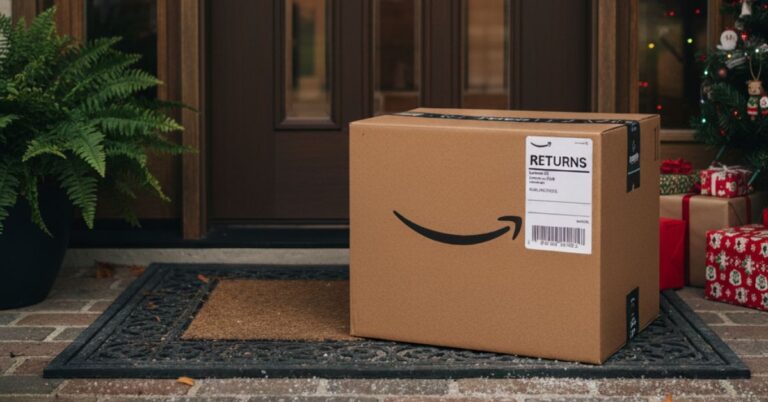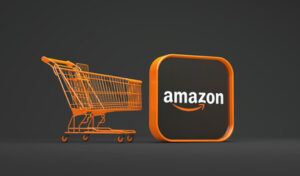
With Amazon doorstep returns, customers can schedule USPS pickups from their doorstep, streamlining returns while raising the bar for convenience in e-commerce logistics.
It’s not the price, the reviews, or even the delivery speed.
The hassle of the return process has long been the accepted, ugly part of e-commerce.
Now, Amazon’s new “Doorstep Returns” service is moving to eliminate that friction entirely, launching a convenience war that could permanently alter what shoppers expect from every brand online.
Amazon Taps USPS to Expand Doorstep Return Options
Saleswarp"In a competitive market, doorstep returns are no longer just a convenience, they are a declaration of customer-centricity."
Amazon is expanding its reverse logistics network by partnering with the U.S. Postal Service for new return pickup options. According to a SupplyChainDive article by Max Garland, this new collaboration began rolling out to some customers this summer.
The service, which an Amazon spokesperson confirmed, is part of a continuous effort to make returns more convenient for eligible items. This new Amazon doorstep returns capability utilizes USPS carriers to retrieve packages directly from customers.
The program’s specific coverage was not detailed by Amazon, but its availability has been confirmed in markets like Nashville, Tennessee. Third Person CEO Matthew Hertz noted the free pickup required the user to provide their own box and shipping label.
This partnership could become a vital part of the USPS’s business as it seeks to improve its financial health. A 2024 report from the agency’s Office of Inspector General identified reverse logistics as a significant growth opportunity.
In fiscal year 2023, the Postal Service generated $665 million in revenue from 132 million returned parcels. The report concluded that USPS could substantially increase revenue by growing its share of this expanding market.
For Amazon, this expansion is a strategic move to prepare for the peak shipping season and the anticipated post-holiday returns surge. A report from the National Retail Federation and Happy Returns projects that 17% of 2025 holiday sales will be returned.
This figure is notably higher than the 15.8% projected for overall annual sales returns this year. The USPS pickup option adds another layer to Amazon’s already extensive returns system.
Customers still have access to a wide variety of other drop-off locations. These partner locations include:
- Staples
- Whole Foods
- The UPS Store
An Amazon spokesperson stated that four out of five U.S. customers are within five miles of one of these 8,000-plus drop-off points. Many of these existing locations offer the convenience of both label-free and box-free returns.
Amazon Doorstep Returns Arrive as Shoppers Prioritize Convenience
A 2024 report from nShift and DeliveryX highlights a growing consumer demand for simpler returns, with 54% of shoppers saying easy returns are very important when buying online. This preference now outweighs priorities such as lowest price or fastest delivery, signaling how post-purchase convenience drives trust and loyalty.
According to the DeliveryX Returns 2024 report, 67% of shoppers say a retailer’s returns policy directly influences how much they trust the brand. Retail reliability also remains a major factor, with two-thirds of shoppers ranking it as a top consideration when deciding where to buy.
The launch of Amazon doorstep returns comes amid this shift in consumer behavior. The service allows customers to schedule doorstep pickups for unwanted items through the U.S. Postal Service, removing barriers to returns and reinforcing Amazon’s focus on convenience.
For sellers, however, the growing demand for effortless returns comes with a cost. As reverse logistics expand, retailers must balance customer expectations with profitability, particularly as the returns process can quietly erode margins if not managed strategically.
Industry experts suggest digital and flexible return systems may offer a middle ground – helping sellers meet consumer expectations without absorbing the full cost of convenience. The introduction of Amazon doorstep returns underscores how returns have evolved from a logistical afterthought into a competitive differentiator in ecommerce.
Doorstep Convenience Meets Seller Fatigue
Will Haire, co-founder of BellaVix, has highlighted the unsustainable cost of returns, which are no longer a minor line item for online sellers. In 2024, 17 percent of all online sales were returned, a rate more than double that of five years prior.
For Amazon sellers, the situation is often far worse, with many reporting return rates three to four times higher than on competing platforms like Walmart or Shopify. Each return is estimated to cost a seller about 30 percent of the item’s price once all shipping, labor, and processing fees are factored in.
This financial drain means a single $50 returned item can wipe out $15 in profit, forcing a seller to sell two or three new units just to break even. When Amazon introduced new return threshold fees in 2024, over 65 percent of sellers reportedly raised their prices to offset the financial hit.
It is within this high-cost environment that Amazon is expanding its convenience-first policies, now launching the new Amazon doorstep returns service. This move further simplifies the return process for consumers, while sellers continue to absorb the escalating financial consequences.
A significant portion of these costs stems from fraudulent returns, which have become a systemic problem. The National Retail Federation estimates that nearly 15 percent of all returns are fraudulent, a dramatic increase from 5 percent in 2018.
Sellers report that Amazon is often treated like a rental service, with rampant abuse and fraud. Common examples of this include:
- Customers purchasing new Nike cleats and returning a box filled with cheap flip-flops.
- Sellers receiving used bars of soap or other worthless junk in place of their returned merchandise.
- Electronics sellers routinely dealing with “part harvesting,” where buyers gut components from MacBooks or chargers and return the empty shells.
This behavior is compounded by “wardrobing” and “bracketing,” where buyers use an item once or order multiple sizes with the intent to return most, treating Amazon as a free fitting room. This abuse has even been professionalized, with fraud-as-a-service rings on TikTok and Telegram teaching shoppers how to get free merchandise at the seller’s expense.
Beyond the immediate financial losses, the reputational damage from Amazon’s return system can be fatal to a brand. Lisa Myers, founder of Ceres Chill, pulled her brand from FBA after Amazon restocked a used breast milk chiller that was returned with another mother’s rotten milk inside.
A family-run swim diaper brand, Beau & Belle Littles, faced a similar crisis when Amazon resold a used, feces-filled diaper to a new customer. The resulting review devastated their sales and left them $600,000 in debt, highlighting the seller’s complete lack of control over their inventory in the FBA network.
Sellers report that Amazon’s protection tools, such as SAFE-T claims, are frequently denied even when clear photo evidence of fraud is provided. Sellers are also unable to block known abusive buyers, leading to a widespread feeling that fraudulent customers face no consequences.
Amazon’s “returnless refund” policy is another major source of seller frustration, as it often forces them to issue a full refund while the customer keeps the product. This creates a “no-win” scenario where sellers are left with no inventory, no money, and no recourse for a claim.
Managing Return Rates as Amazon Doorstep Returns Expand
Amazon’s launch of its new Amazon doorstep returns service aims to create an even more frictionless experience for customers. This convenience-first approach, however, intensifies the pressure on third-party sellers who are struggling to diagnose and manage the complex reasons for returns.
Sellers report that Amazon often fails to provide actionable data, labeling returns with vague reasons like “defective” or “unwanted.” This lack of clarity forces sellers to find their own methods for identifying the root cause of customer dissatisfaction.
A key strategy is for sellers to place their own test orders to see exactly what the customer experiences. This process has uncovered critical fulfillment failures, such as one instance where a five-pound hot sauce bottle was shipped in a simple padded envelope.
Sellers also face challenges in benchmarking their performance, making it difficult to know if their return rate is truly a problem, as explained in the video above. A 9.52% Negative Customer Experience (NCX) rate on a complex motion sensor, for example, may be flagged by Amazon but is actually considered healthy for its category.
This context is critical, as return rate expectations vary wildly by product type. While the sensor’s 9.52% rate is acceptable, other categories have much higher baselines:
- Apparel – Can experience return rates as high as 25%.
- Electronics & Security – Often see rates closer to 15%.
To manage this, many sellers now set an internal “alarm bell” threshold, such as 11%, to trigger action. To stay below this threshold, sellers are bypassing ineffective tactics like follow-up emails, which are rarely read.
The most effective strategies now focus on in-package solutions, such as product inserts that direct a customer to the brand for support instead of initiating a return. The primary goal is to shift focus from minor return rate fluctuations to growing overall sales.
Sellers are advised that once a baseline is stable, the best defense is a strong offense. This involves increasing investment in advertising and user-generated content (UGC) videos to boost sales, which in turn keeps the return percentage low.
Amazon's Holiday Return Window Creates Seller Cash Flow Crisis
Amazon has officially announced its 2025 holiday return window, a seasonal policy that creates a significant operational and financial burden for its third-party sellers. The new policy dictates that any item purchased between November 1st and December 31st can be returned for a full refund until January 15, 2025.
This customer-centric rule effectively creates a three-month return window for early holiday shoppers. While it is designed to accommodate gift-giving, it also compounds the logistical and financial pressures sellers are already battling.
This policy, combined with other convenience-focused services like the new Amazon doorstep returns program, shifts a heavy financial liability onto sellers. Sellers are warned to brace for a sharp increase in their return rates, which are expected to jump by 25% to 50% during this period.
This spike is especially pronounced for “giftable” items, which are returned far more frequently than standard purchases. While a normal return rate for an Amazon agency managing a typical account is between 1-5%, a giftable item can easily exceed this, and apparel often sees rates as high as 10-20% year-round.
The most significant impact on sellers, however, is not the return volume itself but the subsequent squeeze on cash flow. To cover the liability of this extended return window, Amazon automatically holds a larger-than-normal “reserve” from seller payments.
This higher reserve limits a seller’s available capital, creating a cash flow crunch that persists well into the first quarter of the new year. This policy makes it significantly more difficult for sellers, particularly smaller ones, to fund their Q1 inventory purchases.
Sellers must prepare for the following impacts:
- A 25-50% increase in return rates over their baseline.
- A higher cash reserve held by Amazon, limiting available funds.
- A predictable spike in return volume throughout January.
While this return surge will negatively impact metrics, sellers are advised that rates should normalize by February. However, the financial strain from Amazon’s customer-first policies remains a critical challenge for sellers to manage.
Brandon Batchelor"If you make returns hard, use confusing language or charge a fee, nearly three-fourths of consumers indicate they’ll simply go somewhere else that doesn’t."






